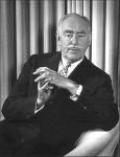Muir struggled for decades to create and protect Yosemite National Park, and helped launch the American environmental movement.
In 1903, Presiden
After she wrote eloquently about her two years wandering along a local creek, studying and jotting thoughts, young Annie Dillard was called by many the “true heir” to Henry Thoreau.
TINKER CREEK, VA — The creek flowed for millions of years but the world beyond its banks was too busy to notice. Then in 1971, a young woman from nearby Roanoke began dropping by.
Grand forces have shaped American biology across the past sixty-six million years, from the Paleocene to now.
It was the lead-up to a presidential election, an unsettling late summer for many Americans since the hugely popular incumbent, Theodore Roosevelt, was declining to run for president a second time.
When the leading European naturalist visited America and met with Thomas Jefferson, it had a profound impact on the young nation.
Editor’s Note: Eleanor Jones Harvey is a senior curator at the Smithsonian American Art Museum.
Critics saw him as weak, but in his one term in office Carter had significant achievements in foreign affairs and environmental and energy policy.
Editor’s Note: The author was a longtime columnist and senior editor at Newsweek, and since has been a television commentator, documentary filmmaker and author of three New York Times bestsellers.
She helped launch the environmental movement and pioneered the idea of the ecology of the human body.
A sad footnote to the horrific shootings in Florida is the soiling of the name of the environmental pioneer for whom the Parkland high school was named.
Skirmishing about environmentalism may well continue forever, but the major war is over. It lasted far longer than most people realize.
The naturalist ALDO LEOPOLD not only gave the wilderness idea its most persuasive articulation; he offered a way of thinking that turned the entire history of land use on its head
The trouble began at midmorning on Wednesday, April 21, 1948, when a neighboring farm’s trash fire got out of control.
American attitudes toward them have taken a 180-degree turn over the last century—and so have the battles they provoke
ORGANIZED AMERICAN ENVIRONMENTALISM IS HARDLY older than this century, and most of its current concerns are younger still. Some of the resources it now tries to protect, in fact, were among its original targets.
THE PICTURE IS MORE HEARTENING THAN ALL THE LITTLE ONES
The Cuyahoga River died for our sins . In 1796 the Cuyahoga, which promised easy transportation into the wilderness of the Ohio country from Lake Erie, prompted the city of Cleveland into existence.
For more than a century now, American homeowners have been struggling to remake their small patch of the environment into a soft, green carpet just like the neighbor’s. Who told us this was the way a lawn had to be?
When it comes to lawn care, my father has always insisted on doing it the hard way. No shortcuts or modern conveniences for him.
Ninety years ago a highborn zealot named Gifford Pinchot knew more about woodlands than any man in America. What he did about them changed the country we live in and helped define environmentalism.
Like most public officials, Gov. Gifford Pinchot of Pennsylvania could not answer all his mail personally. Much of it had to be left to aides, but not all of these realized the character of their boss.
A hundred and fifty years ago, a sea of grass spread from the Ohio to the Rockies; now only bits and pieces of that awesome wilderness remain for the traveler to discover.
Behind my grandparents’ house, the house in which I was born, rose a high pasture, little used in my boyhood and then only for grazing a few head of cattle.
A HERITAGE PRESERVED
Since 1930, more than half of America’s splendid elm trees have succumbed to disease. But science is now fighting back and gaining ground.
They left behind great names —the Divine Elm, the Justice Elm, the Pride of the State, the Green Tree.
Did the Indians have a special, almost noble, affinity with the American environment—or were they despoilers of it? Two historians of the environment explain the profound clash of cultures between Indians and whites that has made each group almost incomprehensible to the other.
When the historian Richard White wrote his first scholarly article about Indian environmental history in the mid-1970s, he knew he was taking a new approach to an old field, but he did not realize just how new it was.
Did the Indians have a special, almost noble, affinity with the American environment—or were they despoilers of it? Two historians of the environment explain the profound clash of cultures between Indians and whites that has made each group almost incomprehensible to the other.
When the historian Richard White wrote his first scholarly article about Indian environmental history in the mid-1970s, he knew he was taking a new approach to an old field, but he did not realize just how new it was.
We talk about it constantly and we arrange our lives around it. So did our parents; and so did the very first colonists. But it took Americans a long time to understand their weather—and we still have trouble getting it right.
Weather makes news headlines almost every day in some community in the United States.
Banished from public view in our cities, this two-hundred-year-old import is alive and well behind the scenes
“SHE LOOKED DOWN into the yard. The tree whose leaf umbrellas had curled around, under and over her fire escape had been cut down because the housewives had complained that wash on the lines got entangled in its branches.
It’s our most important, profitable, and adaptable crop—the true American staple. But where did it come from?
In 1748 an inquisitive Swede named Peter Kalm, a protégé of the great botanist Linnaeus, came to America to find plants that could be useful in his country. He went around asking questions of everybody about everything.
Piskiou,Vaches Sauvages, Buffler, Prairie Beeves—
One morning in July, 1966, a lone buffalo bull grazed near the highway on the mountain between Virginia City and Ennis, Montana, unmindful of the click of camera shutters or the rustle of hesitant tourists getting in and out of automobiles.
So read a welcoming sign over the door of Charles Willson Peale’s great ill-fated museum
In the summer of 1786, an advertisement heralding the appearance of a revolutionary new institution appeared in the Pennsylvania Packet: “ MR.
During the spring of 1801 Charles Willson Peale learned of a remarkable discovery—the huge bones of an “animal of uncommon magnitude” had been found in Orange and Ulster counties north of New York City.
He was the first Englishman to give a detailed description of the North American wilderness. Was it a pack of lies?
“Does the name David Ingram mean anything to you?” I have been going around asking. The answer is almost always no. Yet if Ingram is to be believed, he and two others with him accomplished perhaps the outstanding walk in recorded history.
One hundred years ago, Congress created two agencies—the U.S. Geological Survey and the Bureau of Ethnology. Both, according to the author, have since “given direction, form, and stimulation to the science of earth and the science of man, and in so doing have touched millions of lives.”
The quietly compelling legend of America’s gentlest pioneer
“There is in the western country a very extraordinary missionary of the New Jerusalem. A man has appeared who seems to be almost independent of corporal wants and sufferings.
The Garden Club of America-once the diversion of leisured ladies—is now a vigorous environmental league
The young should be trained to love flowers and take care of the garden shrubberies. Such knowledge and taste are greatly needed in our land,” counseled Godey’s Lady’s Book in 1858.
The Colonial Status—Past and Present—of the Great American West
The pelts of beaver, the dust of placer gold, the tongues and hides of buffalo, the proteinaceous feed of native grass, the smeltings of precious and commercial minerals, the viscous gush of oil: these have been the elementals of the American West shipped eas
The Last Stand of King Grizzly
Bears and people have been at war for a long time-possibly longer than two predatory mammals should be, with any hope of mutual survival. In the beginning, the bears won almost every time, though not as often as the great cats did.
A Last Link with the Living Frontier





